Applying fabric paint with fabric softener is a creative technique that can give your textile projects a unique look and feel. Here fabric paint is mixed with fabric softener to create a printing paste. This paste is used to paint fabric furniture or other fabric. This method can be particularly useful for achieving softer textures on fabric that has been painted, as fabric paint can sometimes stiffen the material. Here’s a step-by-step introduction to using fabric paint with fabric softener:
Materials Needed For Steps:
Need material for every step
- Gather Materials:
- Fabric Paint
- Fabric Softener
- Mixing Bowl
- Spoon
- Paintbrush
- Plain Piece of Cloth
- Mix Paint with Fabric Softener:
- Fabric Paint
- Fabric Softener
- Mixing Bowl
- Spoon
- Dip the Paintbrush:
- Paintbrush
- Bowl with Mixed Paint and Fabric Softener
- Paint on the Fabric:
- Paintbrush with Paint
- Piece of Cloth being painted on
Process Steps:
Fabric painting with fabric softener involves a simple process that allows you to create soft, vibrant designs on fabric. Here’s a brief overview of the steps:
Step 01: Gather Materials:
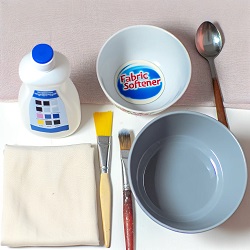
Start by collecting all necessary items: fabric paint, fabric softener, a mixing bowl, a spoon, a paintbrush, and a piece of plain cloth.
Step 02: Mix Paint and Fabric Softener:
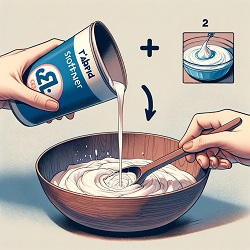
In the mixing bowl, combine fabric paint with a small amount of fabric softener. The softener will help the paint spread more easily and penetrate the fabric for a softer finish. Use the spoon to stir the mixture until it is well combined.
Step 03: Prepare the Paintbrush:
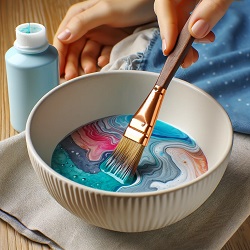
Dip your paintbrush into the mixed paint and fabric softener, ensuring the brush is evenly coated with the paint mixture.
Step 04: Paint on Fabric:
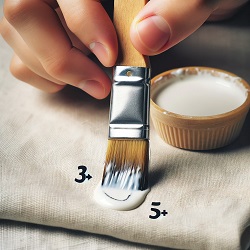
Apply the paint to your fabric, using the brush to create your desired design. The fabric softener in the paint mixture will help the paint flow smoothly and improve the fabric’s hand feel after painting.
Step 05: Let it Dry and Set:
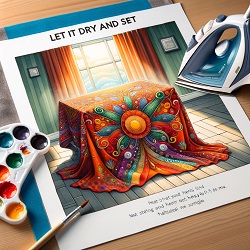
Once you’re satisfied with your design, allow the paint to dry completely. Depending on the paint and fabric softener mix, you may also need to heat set the paint according to the paint manufacturer’s instructions to ensure durability and washability.
Step 06: Finalize:
After the paint has dried and been set, your fabric is ready to use for various crafts, clothing, or decorative purposes. The addition of fabric softener to the paint ensures that your painted fabric remains soft and flexible.
This process adds a unique touch to fabric items, allowing for custom designs that stand out with the added benefit of a soft texture
Technical Tips:
- Experiment with different ratios of paint to softener for varied effects.
- Use fabric softener sparingly to avoid overly diluting the paint, which can reduce its color vibrancy and coverage.
- Consider the fabric’s end use when choosing your fabric paint and softener mixture. Some applications may require more durability than others.
This technique of applying fabric paint with fabric softener can add a novel dimension to your fabric painting projects, allowing for more flexibility and creativity in your designs. Enjoy experimenting with different textures and effects!
Why fabric paint with fabric softener is so popular?
The popularity of using fabric paint with fabric softener in the present world can be attributed to several key factors that align with contemporary crafting trends, environmental consciousness, and the DIY (Do-It-Yourself) movement. Here’s why this technique has gained traction:
1. Enhanced Softness and Comfort:
One of the primary reasons for mixing fabric paint with fabric softener is to maintain or enhance the softness of the fabric after painting. Traditional fabric paints can leave the fabric feeling stiff or crunchy, which is not ideal for clothing or soft furnishings. The addition of fabric softener mitigates this effect, making the painted fabric more comfortable to wear or use.
2. Customization and Personalization:
The DIY movement has seen a resurgence, with more individuals seeking ways to personalize their belongings or create custom gifts. Fabric painting with softeners allows for a high degree of customization in textile projects, from clothing and accessories to home decor, enabling people to express their style or create bespoke items that can’t be found in stores.
3. Sustainability and Upcycling:
There’s a growing trend towards sustainability and the upcycling of existing materials to reduce waste. Using fabric paint with softener can give new life to old garments or textiles, transforming them into something new and unique without the need to purchase new items. This approach supports environmental sustainability by extending the life of fabrics.
4. Accessibility and Ease of Use:
This technique does not require specialized equipment or skills, making it accessible to a wide audience, including beginners. The simplicity of mixing fabric paint with fabric softener and applying it to textiles means that more people can undertake fabric painting projects at home, contributing to its popularity.
5. Innovative Textile Art:
The textile arts field is continually evolving, with artists and hobbyists alike seeking new methods and mediums to express their creativity. The use of fabric softener with fabric paint represents an innovative approach to textile art, allowing for experimentation with textures, finishes, and effects that go beyond traditional fabric painting techniques.
6. Social Media and Online Communities:
The rise of social media and online communities dedicated to crafting and DIY projects has facilitated the sharing of techniques, including using fabric paint with softener. As individuals share their projects and success stories online, others are inspired to try these techniques, contributing to their popularity.
7. Economic Benefits:
Customizing or upcycling fabrics with paint and softener can be a cost-effective way to refresh a wardrobe or redecorate a home without significant investment. This economic benefit is especially appealing in times when consumers are looking for ways to save money without compromising on style or personal expression.
In summary, the popularity of fabric paint with fabric softener is driven by its versatility, ease of use, and alignment with broader trends in sustainability, customization, and DIY culture. This technique offers a unique combination of practical and creative benefits that appeal to a wide range of individuals.
FAQ: Fabric Paint with Fabric Softener
Can I use fabric softener to make fabric paint?
Yes, you can mix fabric softener with fabric paint to create a softer texture on the fabric, preventing it from becoming stiff after painting.
What happens when you mix fabric softener with paint?
When fabric softener is mixed with paint, it can dilute the paint slightly and modify its texture, resulting in a softer finish on the fabric which is more comfortable to wear or use.
What do you mix with fabric paint?
Apart from fabric softener, you can mix a textile medium with fabric paint to increase its flexibility and improve its washability, or water to thin it out for lighter applications.
How do you make fabric paint softer?
To make fabric paint softer, add fabric softener to the paint before application. This helps keep the fabric soft and pliable, even after the paint dries.
How do you soften dried paint?
To soften dried paint on fabric, you can gently rub the area with a mixture of water and fabric softener, or apply heat using an iron with a pressing cloth over the painted area to help relax the paint.
How do you make cheap fabric soft?
To soften cheap fabric, soak it in a mixture of water and fabric softener or vinegar before washing. This can help break down the fibers and make the fabric feel softer.
What is a natural fabric softener?
A natural fabric softener can be something as simple as white vinegar or baking soda. These substances soften fabric fibers without the chemicals found in commercial softeners.
What is the best homemade fabric softener?
The best homemade fabric softener often involves using white vinegar mixed with water, and optionally, a few drops of essential oils for fragrance. It’s natural, effective, and gentle on fabrics.
What is the best fabric softener?
The best fabric softener varies based on personal preference, fabric type, and environmental concerns. Some prefer natural options like vinegar for its gentleness, while others may choose commercial brands for their scent and softening power.
What fabric Cannot use softener?
Fabrics such as microfiber, sportswear, flame-resistant materials, and water-repellent fabrics should not be treated with fabric softener as it can diminish their functional properties.
Can I mix vinegar and fabric softener?
It’s not recommended to mix vinegar and fabric softener together, as they serve different purposes and their chemical compositions might not be compatible.
Can I put vinegar in fabric softener?
Yes, vinegar can be used in the fabric softener dispenser of your washing machine as a natural alternative to commercial softeners.
Some related topics about fabric paint & fabric softener:
Fabric Paint for Softening
Fabric paint formulated to maintain or enhance the softness of fabric after drying, resulting in a comfortable texture on painted fabric.
Soft Fabric Paint
Fabric paint designed to produce a soft and flexible finish on fabric, ensuring comfort and flexibility in wearable or touchable items.
Fabric Softener Paint Additive
Additives mixed with fabric paint to enhance softening properties, often containing fabric softeners or other conditioning agents.
DIY Fabric Softening Paint
Homemade mixtures combining fabric paint with fabric softening ingredients to achieve a softer finish on painted fabric, suitable for DIY projects.
How to Make Fabric Paint Softer
Methods and techniques for softening fabric paint, including mixing with fabric softener, using textile mediums, or applying heat to the painted fabric.
Best Fabric Paint for Softening
Recommendations for fabric paint products specifically designed to maintain or enhance the softness of fabric after painting, providing a comfortable feel.
Fabric Paint Softener Mix
Mixtures or ratios of fabric paint to fabric softener or other softening agents to achieve the desired level of softness in painted fabric, customizable based on preference.
Fabric Paint with Built-in Softener
Fabric paint products containing built-in softening agents or additives, eliminating the need for additional mixing or treatments to achieve softness.
Softening Fabric with Paint
Techniques for softening fabric using fabric paint, including application methods, mixing ratios, and post-painting treatments to ensure a soft and comfortable finish.
Paint Additive for Fabric Softening
Products or additives specifically designed to be mixed with fabric paint to soften fabric during the painting process, enhancing the fabric’s comfort and flexibility.
YOU SHOULD KNOW ABOUT FABRIC PAINTING AND ITS TYPE FOR A BETTER UNDERSTANDING
Garments Fabric Printing || How Many Types Of Printing Methods in Garments?
You should read Related